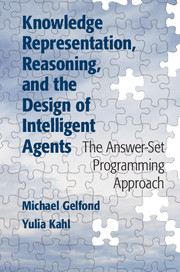 Knowledge Representation, Reasoning, and the Design of Intelligent Agents
Knowledge Representation, Reasoning, and the Design of Intelligent Agents Published online by Cambridge University Press: 05 July 2014
Answer Set Prolog is a comparatively new knowledge representation (KR) language with roots in older nonmonotonic logics and the logic programming language Prolog. Early proponents of the logical approach to artificial intelligence believed that the classical logical formalism called first-order logic would serve as the basis for the application of the axiomatic method to the development of intelligent agents. In this chapter we briefly describe some important developments that forced them to question this belief and to work instead on the development of nonclassical knowledge representation languages including ASP. To make the chapter easier for people not familiar with mathematical logic, we give a very short introduction to one of its basic logical tools — first-order logic.
First-Order Logic (FOL)
First-order logic is a formal logical system that consists of a formal language, an entailment or consequence relation for this language, and a collection of inference rules that can be used to obtain these consequences. The language of FOL is parametrized with respect to a signature Σ. The notions of term and atom over Σ are the same as those defined in Section 2.1. The statements of FOL (called FOL formulas) are built from atoms using boolean logical connectives and quantifiers ∀ (for all) and ∃ (there exists). Atoms are formulas. If A and B are formulas and X is a variable, then (A ∧ B), (A ∨ B), (A ⊃ B), ¬A, ∀ X A, ∃X A are formulas.
To save this book to your Kindle, first ensure no-reply@cambridge.org is added to your Approved Personal Document E-mail List under your Personal Document Settings on the Manage Your Content and Devices page of your Amazon account. Then enter the ‘name’ part of your Kindle email address below. Find out more about saving to your Kindle.
Note you can select to save to either the @free.kindle.com or @kindle.com variations. ‘@free.kindle.com’ emails are free but can only be saved to your device when it is connected to wi-fi. ‘@kindle.com’ emails can be delivered even when you are not connected to wi-fi, but note that service fees apply.
Find out more about the Kindle Personal Document Service.
To save content items to your account, please confirm that you agree to abide by our usage policies. If this is the first time you use this feature, you will be asked to authorise Cambridge Core to connect with your account. Find out more about saving content to Dropbox.
To save content items to your account, please confirm that you agree to abide by our usage policies. If this is the first time you use this feature, you will be asked to authorise Cambridge Core to connect with your account. Find out more about saving content to Google Drive.